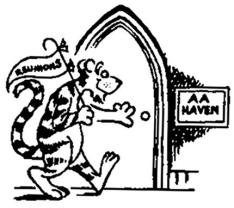July 15, 1925 – June 30, 2020
A little drawing appeared around Reunions in 1983. It showed a smiling tiger strolling into Murray-Dodge Hall to the new AA Haven, set up to support alumni during Princeton’s annual alcohol-laden bash.
The drawing was the handiwork of longtime New Yorker cartoonist Henry Martin ’48, who brought humor to Princeton for decades. His friend and publisher, Charles Scribner III ’73 *77, recalls the picture as a perfect example of how Martin’s art was as kind, generous, and charming as the artist himself.
“It was just a little vignette, but it was lighthearted and it made the whole thing seem unthreatening. And thoroughly Princetonian,” says Scribner, who edited Martin’s two books of cartoons. “It illustrates that Henry Martin had a great sensitivity to using his talent and his wit and his graphic skills to do good.”
Martin loved the whims and absurdities of daily life. Married couples at the dinner table appeared often in his cartoons, as did the business world he learned about from his father, who ran a company. Princeton — the Princeton of an era gone by — frequently appeared, too, as in one cartoon with a road sign that reads, “Zip code: 08540. Area code: 609. Dress code: tie & jacket.”
Sometimes cartoonists deliver humor at someone else’s expense, but not Martin, Scribner says. “He always did it with a chuckle, never an elbow to the side.”
Martin lived in Princeton and worked out of a one-room cottage at the corner of William and Charlton streets, at a drawing board his parents bought when he was 12. On Wednesdays he’d peddle his cartoons to publications in New York and have lunch with a cadre of New Yorker cartoonists. He loved the camaraderie, says one of his two daughters, Jane Read Martin.
The New Yorker published nearly 700 of his cartoons over 35 years, but first Martin spent four years submitting 20 a week only to see them all rejected — a sort of trial newbies were put through in those days, says fellow New Yorker cartoonist Michael Maslin. Martin had an innate fun about him that transferred onto the page, Maslin says, and he was tremendously industrious.
“To do it for that long, the word ‘love’ comes into it,” Maslin says.
Martin’s work appeared in many other magazines, including Punch and The Saturday Evening Post, and he illustrated many books, including one of The Baby-Sitters Club novels written by his daughter Ann M. Martin. His daily syndicated newspaper cartoon, “Good News/Bad News,” ran for 15 years. He donated hundreds of his original New Yorker cartoons and “spot” drawings to the Princeton University Library.
His daughters say their father loved Christmas, inventing stories, magic tricks, and his alma mater. Jane recalls that when she was small, she once said, “Bless spinach,” during grace at a family dinner. Tickled, her father turned that into a cartoon. And as he often did for people who gave him ideas, he gave her a cut of the profits. It bought her a 10-speed bicycle.
“He was just the gentlest, nicest, kindest, quietly funny man,” she says.
Elisabeth Hulette Daugherty is PAW’s digital editor.
Read a personal tribute to Martin by his son-in-law Douglas McGrath ’80, a playwright.



